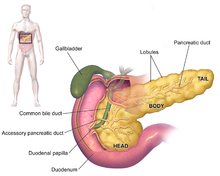Pancreatic fistula
| Pancreatic fistula | |
|---|---|
 | |
| Anatomy of pancreas | |
| Specialty | General surgery |
A pancreatic fistula is an abnormal communication between the pancreas and other organs due to leakage of pancreatic secretions from damaged pancreatic ducts. An external pancreatic fistula is one that communicates with the skin, and is also known as a pancreaticocutaneous fistula, whereas an internal pancreatic fistula communicates with other internal organs or spaces. Pancreatic fistulas can be caused by pancreatic disease, trauma, or surgery.
Signs and symptoms
Marked recent weight loss is a major clinical manifestation, and unresponsiveness of the ascites to diuretics is an additional diagnostic clue.
Pathogenesis
Internal pancreatic fistulas are most commonly caused by disruption of the pancreatic duct due to chronic pancreatitis. The chronic pancreatitis is usually alcoholic in origin in adults, and traumatic in origin in children. They may also be caused by leakage from a pancreatic pseudocyst.
Anterior disruption of a pseudocyst or a pancreatic duct leads to leakage of pancreatic secretions into the free peritoneal cavity, leading to pancreatic ascites. If the duct is disrupted posteriorly, the secretions leak through the retroperitoneum into the mediastinum via the aortic or esophageal hiatus. Once in the mediastinum, the secretions can either be contained in a mediastinal pseudocyst, lead to enzymatic mediastinitis, or, more commonly, leak through the
Diagnosis
Pleural or ascitic fluid should be sent for analysis. An elevated
Types
External
An external pancreatic fistula is an abnormal communication between the pancreas (actually pancreatic duct) and the exterior of the body via the abdominal wall.
Loss of bicarbonate-rich pancreatic fluid via a pancreatic fistula can result in a hyperchloraemic or normal anion gap metabolic acidosis. Loss of a small volume of fluid will not cause a problem but an acidosis is common if the volume of pancreatic fluid lost from the body is large.
Internal
First described by Smith (1953),[3] and elaborated upon by Cameron et al. (1976),[1] internal pancreatic fistulas can result in pancreatic ascites, mediastinital pseudocysts, enzymatic mediastinitis, or pancreatic pleural effusions, depending on the flow of pancreatic secretions from a disrupted pancreatic duct or leakage from a pseudocyst.[1]
Treatment
The production of pancreatic enzymes is suppressed by restricting the patient's oral intake of food patient in conjunction with the use of long-acting
Fistulectomy is done in which the involved part of the pancreas is also removed.
References
- Bibliography
- Brooks JR (1983). "Pancreatic ascites". In Brooks JR (ed.). Surgery of the Pancreas (1st ed.). Philadelphia: WB Saunders. pp. 230–232. ISBN 0-7216-2082-5
- Dugernier T, Laterre PF, Reynaert MS (2000). "Ascites fluid in severe acute pancreatitis: from pathophysiology to therapy". Acta Gastroenterol Belg. 63 (3): 264–8. PMID 11189983.
- Iacono C, Procacci C, Frigo F, Andreis IA, Cesaro G, Caia S, Bassi C, Pederzoli P, Serio G, Dagradi A (1989). "Thoracic complications of pancreatitis". Pancreas. 4 (2): 228–36. S2CID 24341561.
- Kaman L, Behera A, Singh R, Katariya RN (2001). "Internal pancreatic fistulas with pancreatic ascites and pancreatic pleural effusions: recognition and management". ANZ J Surg. 71 (4): 221–5. S2CID 33251283.
- Takeo C, Myojo S (2000). "Marked effect of octreotide acetate in a case of pancreatic pleural effusion". Curr Med Res Opin. 16 (3): 171–7. PMID 11191006.
